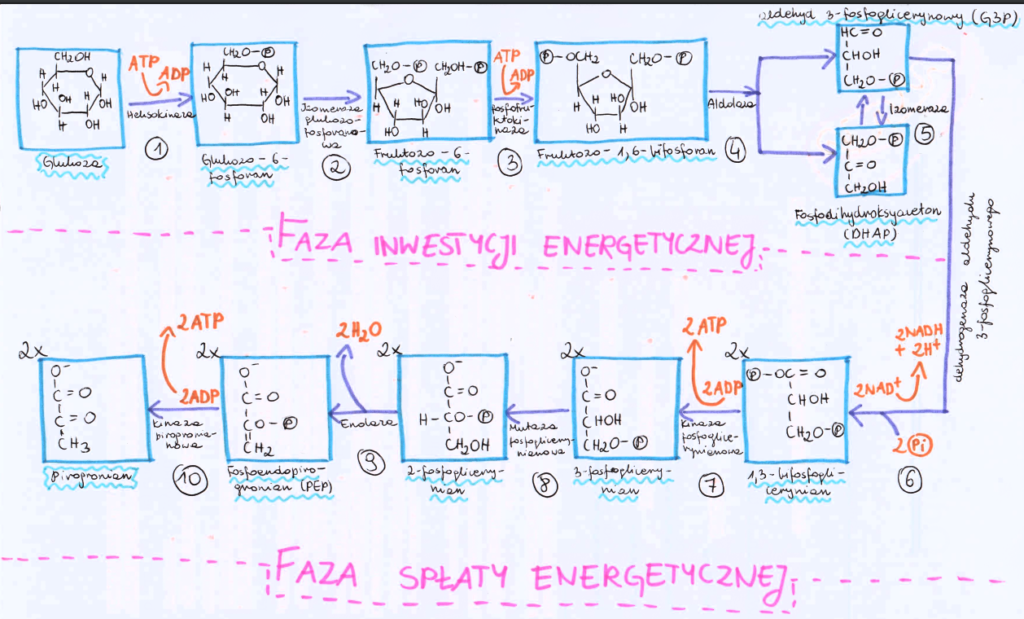Glycolysis – sweet metabolism 4th December 2023 – Tags: Biochemical, cellular respiration, Glycolysis
In today’s article, we will dive again into the biochemical processes that occur during a process called cellular respiration or Glycolysis. Although we know that this topic will be of greater interest to high school graduates or students of biological and medical faculties, we also encourage others interested in the topic of our body. There are many interesting processes happening in our body, and this is just one of them!
What is the process of glycolysis?
Glycolysis is nothing more than one of the metabolic pathways occurring in our cells. More specifically, this process occurs during cellular respiration. As a result of this process, we obtain energy that our body can use in further stages of respiration, or that anaerobic organisms can use for their life processes. Well, glycolysis itself occurs without the use of oxygen, so it occurs in both the anaerobic and aerobic pathways. During glycolysis, glucose undergoes numerous transformations until it reaches its final form – pyruvate. The entire process takes place in the cell cytoplasm.
Stages of glycolysis:
- During the first stage, a phosphate residue is attached to glucose using an enzyme called hexokinase. We obtain our phosphate residue from the breakdown of the ATP molecule. The reaction product is glucose-6-phosphate
- Glucose-6-phosphate is isomerized by the enzyme glucose-phosphate isomerase. The result is fructose-6-phosphate.
- Another ATP molecule breaks down, resulting in a free phosphate residue, which is then attached to fructose-6-phosphate. The process occurs under the influence of catalysis by phosphofructokinase. The reaction product is fructose-1,6-bisphosphonate
- Under the influence of the aldolase enzyme, fructose-1,6-bisphosphonate is converted into 3-phosphoglyceraldehyde and phosphodihydroxyacetone. The products are isomers of each other.
- With the participation of isomerase, phosphodihydroxyacetone is converted into 3-phosphoglyceraldehyde.
- Two important processes take place during this stage. An enzyme called glyceraldehyde-3-phosphoaldehyde dehydrogenase catalyzes a reaction that transfers one hydrogen molecule from glyceraldehyde-3-phosphoaldehyde to NAD+, yielding NADH + H+. Additionally, glyceraldehyde-3-phosphoaldehyde dehydrogenase catalyzes a reaction that transfers a phosphate group to oxidized glyceraldehyde phosphate. As a result, we obtain 1,3-bisphosphoglycerate.
- The phosphate group is transferred from 1,3-bisphosphoglycerate to ADP, creating an ATP molecule. The reaction occurs with the help of the enzyme phosphoglycerate kinase. We obtain 3-phosphoglycerate.
- The phosphate group from both phosphoglycerate molecules is transferred from the position at the third carbon atom to the second carbon atom. As a result, we obtain two molecules of 2-phosphoglycerate. The reaction is catalyzed by the enzyme phosphoglycerate mutase.
- The enzyme enolase removes a water molecule from 2-phosphoglycerate to obtain phosphoenolpyruvate.
- The phosphate group from phosphoenolpyruvate is transferred to ADP to obtain an ATP molecule. The process is catalyzed by the enzyme pyruvate kinase. As the final stage of glycolysis, we obtain two ATP molecules and two pyruvate molecules.


What happens after glycolysis?
As a product of glycolysis, we obtain two molecules of pyruvate. Subsequently, pyruvate may undergo specific transformations. If we talk about the fermentation process, we can obtain ethyl alcohol or lactic acid (alcohol – alcoholic fermentation, lactic acid – lactic fermentation). Pyruvate can also be converted into acetyl-coenzyme A during a bridging reaction, where it will then be transferred to the Krebs cycle.



